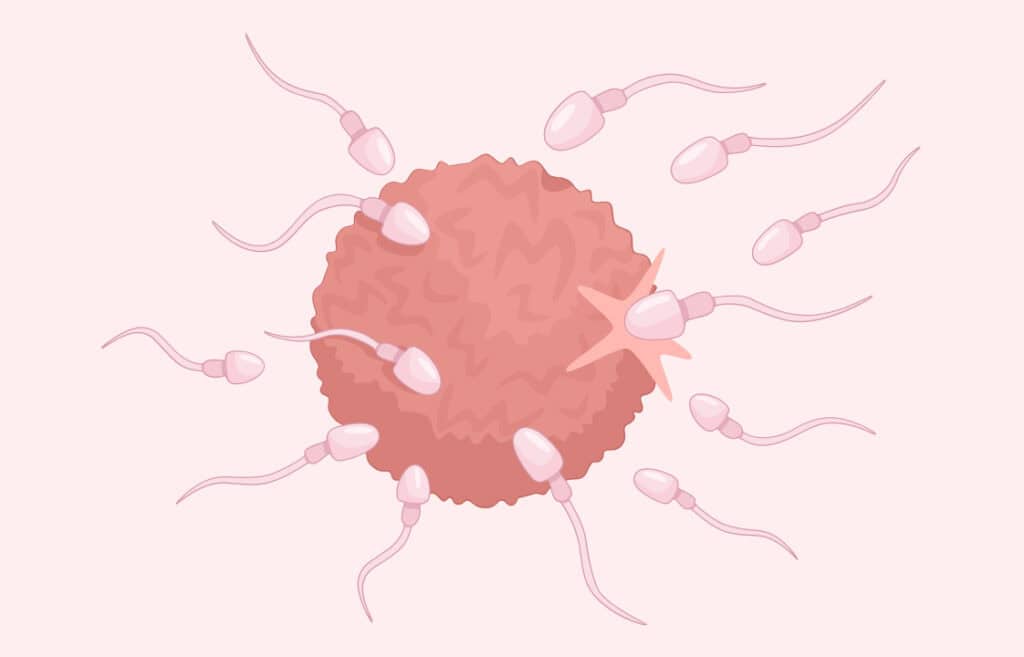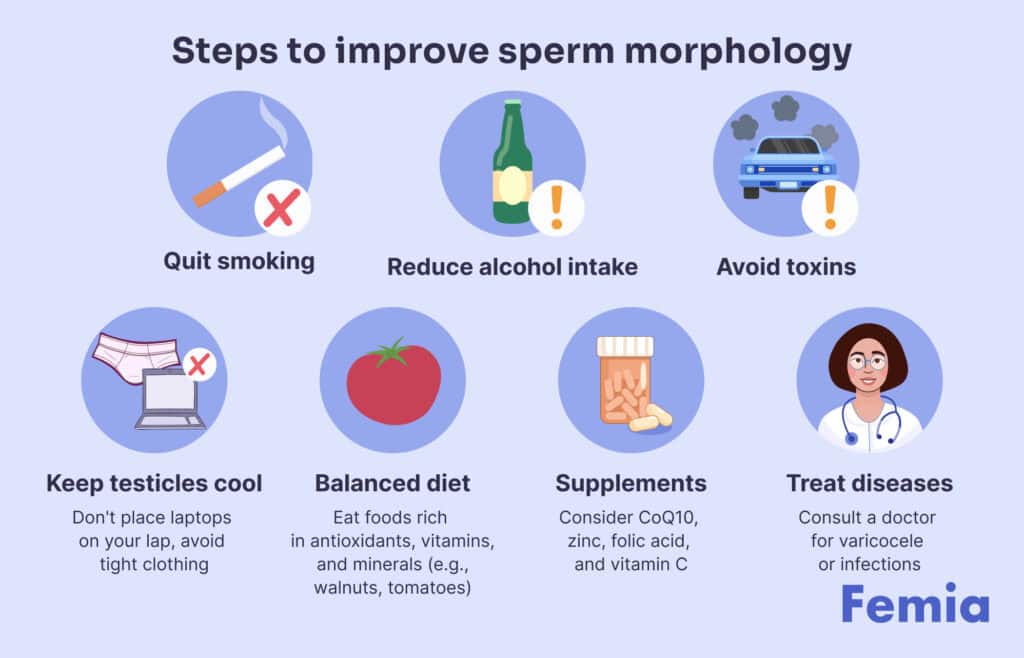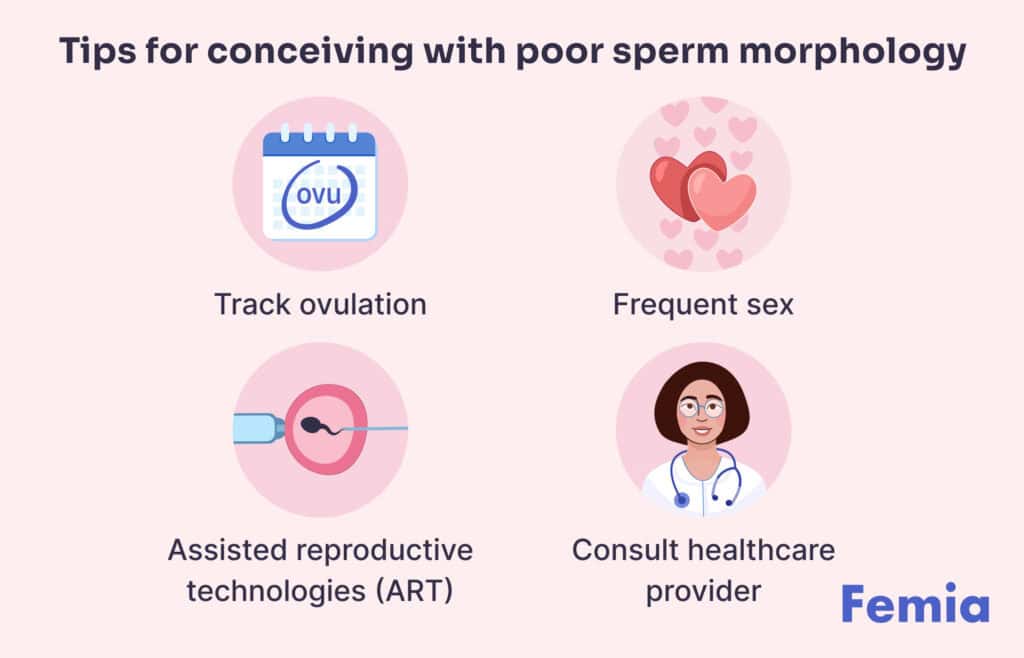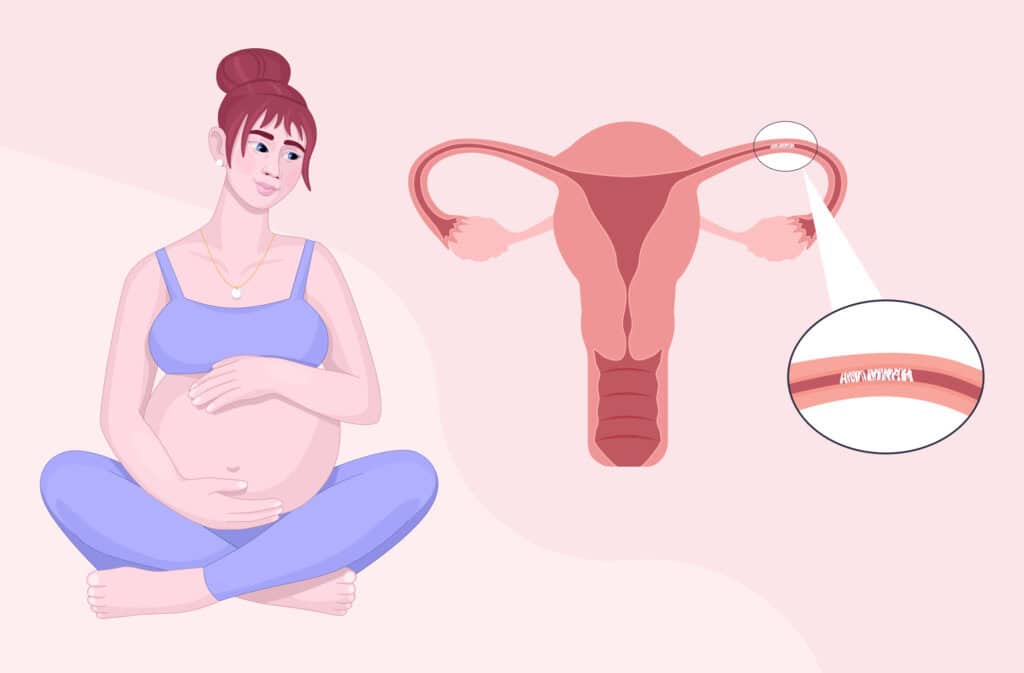Femia > Health Library > Getting Pregnant > Challenges > How to get pregnant with poor sperm morphology?
How to get pregnant with poor sperm morphology?

- Updated Feb 10, 2025
- Published
CRAFTED BY HUMAN
Crafted by human At Femia, we provide accurate and up-to-date information at every stage of your journey, from trying to conceive, pregnancy and postnatal support. All content is created by a real person based on in-depth research and own professional experience. Femia ensures that you will receive expert advice, strict accuracy and a personalized approach from our authors/medical experts. Learn more about our editorial policy.
FACT CHECKED
Fact checked At Femia Health, we maintain the highest standards of editorial excellence in delivering content focused on helping you conceive, guiding you through pregnancy, and supporting you postpartum. Explore our content review principles to learn how we ensure the accuracy and quality of our health and lifestyle tips for every stage of your journey.
You can improve sperm morphology by improving your lifestyle, limiting exposure to harmful toxins, and keeping your testicles at the correct temperature. To improve the chance of conception with poor sperm morphology, you can track your cycle and have sex during your fertile window.
Around one in eight couples struggle to conceive. One of the fertility tests offered to couples struggling to conceive is the semen analysis test. This test uses a microscope to look at the quantity, quality, and motility of sperm. If you are found to have a high number of abnormal sperm, this is known as poor sperm morphology.
If you’ve recently been diagnosed with poor sperm morphology, you may be worrying about whether you’ll be able to have a baby and how long it might take to conceive. One of the most crucial things to remember is that abnormal sperm are very common.
In fact, in the average sample, you would expect only around 10 percent of the sperm to be free from abnormalities.
Though an abundance of abnormal sperm sounds like a bad thing, it is still possible to conceive naturally with this diagnosis. Sperm morphology can change over time, so it’s not too late to improve sperm health.
Morphology of sperm: What is that?
Sperm morphology refers to the size and shape of the sperm. Normal sperm have oval heads and long tails; this streamlined shape allows the sperm to swim fast and efficiently to the egg. There are a number of common potential defects that can affect fertility, including large heads, misshapen heads, and double tails. These defects may reduce the chances of the sperm reaching and fertilizing the egg, though this is not always the case.
When a couple experiences issues conceiving, sperm analysis is used to determine male fertility. During a semen analysis test, sperm morphology is examined to find out whether there are a high number of defects present. If you get one of these tests, the results will be given as a percentage of sperm that don’t appear to have defects when observed through a microscope.
While you may panic about having abnormal sperm, in fact, very few sperm look perfect under a microscope. Generally, around four to 10 percent of the sperm in a semen sample will be typical.
Though sperm morphology is a commonly used test, it is not an exact science. If your sperm morphology results are almost 0 percent normal forms (NF), this may indicate infertility. Though this is a standard fertility test, it is generally thought to be of little use for most men. A 2017 study published in the Asian Journal of Andrology found that men with 0 percent sperm morphology were still able to conceive naturally.

Causes of abnormal sperm morphology
Abnormal sperm morphology can be caused by a number of factors, including:
Genetic factors: Some men have genetic conditions that impact sperm abnormalities.
Lifestyle factors: Smoking and daily alcohol consumption can cause abnormal sperm morphology. Luckily, lifestyle changes can improve sperm morphology and increase the chances of conception. Quitting smoking and reducing your alcohol intake could reduce the number of abnormal sperm.
Nutritional deficiencies: A healthy diet plays an essential role in fertility. Nutritional deficiencies can impact the body’s ability to make healthy sperm. In particular, B12 deficiency can impact sperm quality and reduce the chance of conception.
Environmental factors: Unfortunately, the toxins and chemicals we are exposed to on a daily basis can impact fertility. Pesticides, air pollution, and other chemicals are linked with poor sperm morphology.
Medical conditions: Some underlying medical conditions can cause sperm morphology problems. For example, varicocele, a mass of varicose veins in the testicles, can reduce sperm quality and cause poor sperm morphology. Infections like epididymitis and orchitis, as well as some sexually transmitted infections, can also impact sperm morphology.
How to correct sperm morphology
While hearing you have low sperm morphology may be quite disheartening, the good news is you can take steps to improve your sperm morphology today.
Lifestyle changes
The following lifestyle changes may help to improve sperm morphology:
Quit smoking
A 2019 research review in BMC Public Health found that higher rates of sperm defects were seen in the semen samples of smokers. It’s not easy to give up smoking, but it is possible. Contact your healthcare provider for advice and support. It’s better to quit long before the baby arrives, so now is the perfect time to start.
Reduce alcohol consumption
Regular alcohol consumption can impact sperm quality, too, so reducing your intake is an easy way to improve your sperm health. A 2017 study published in Reproductive Biomedicine Online found that daily alcohol consumption was associated with worse sperm morphology.
Drinkingalcohol is often a deeply ingrained habit, but it is possible to cut down your intake. Start by replacing your daily alcoholic drink with an alcohol-free alternative. This way, you’ll still have the routine and flavor without the alcohol (and associated sperm defects). When you do have a social event where you’d like to drink alcohol, try to drink a little less than you would have previously.
Avoid exposure to environmental toxins and harmful chemicals
Besides reducing your alcohol intake and quitting smoking, there are other environmental toxins and harmful chemicals to avoid. Pesticides in food can impact fertility and sperm morphology, so switching to an organic diet may help to improve sperm health.
Regular exposure to air pollution also impacts sperm morphology, too. If you live near a busy road, air pollution could be playing a role in your sperm quality. The further away from cars or construction, the lower the air pollution levels will be.
Avoid overheated testicles
A 2018 study published in Safety & Health at Work found that elevated testicle temperature was associated with sperm abnormalities. Despite its name, your laptop shouldn’t sit on your lap. Resting your laptop on your lap can increase the temperature of your testicles and increase your risk of sperm abnormalities. You may also wish to avoid tight underwear and clothing that can encourage overheating.
Diet and supplements
The food you eat matters, and paying close attention to your diet could improve your chances of conceiving. Try to eat a balanced diet rich in antioxidants, vitamins, and minerals. Walnuts, tomatoes, pumpkin seeds, and bananas are foods that improve sperm quality. Focus on eating fresh foods for a healthy, balanced diet, and reduce your reliance on junk food, ultra-processed foods, and processed meats.
Many people take supplements during their fertility journey to ensure their body has enough of the nutrients necessary for conception. A 2016 study published in the International Journal of Reproductive Biomedicine found that CoQ10 supplementation improves sperm morphology when taken for three months. However, further research is needed to confirm this effect.
Consider supplements like zinc, folic acid, and vitamin C, as well, but always consult a healthcare provider first—accidentally consuming surplus amounts of a nutrient can have its own negative effects.
Medical treatments
As part of your fertility screening, your doctor should check for any underlying medical issues that may be impacting your fertility. For example, untreated varicocele could be causing your sperm morphology issues. A 2021 study published in Andrology found that varicocele treatment improved sperm morphology.
And, as mentioned above, there are a number of infections that can cause sperm abnormalities as well. Your doctor should test for the relevant infections and treat any that come back positive.

How to get pregnant with poor sperm morphology
Hearing you have poor sperm morphology can be disheartening for you and your partner. You may worry about your chances of conception and how long it will take. Luckily, there are steps you can take to improve your chances of conception with poor sperm morphology, including:
Timing sex
If you’ve been trying to conceive for a while and it’s not happening, you could be having sex at the wrong time. The best way to ensure you’re having sex at the right time is to track your ovulation cycle.
A woman’s fertile window is typically the five days before ovulation, the day of ovulation, and the day after ovulation. Tracking changes like basal body temperature or using ovulation tests can help identify your fertile window and increase chances of conception.

Healthy lifestyle for both partners
Lifestyle plays a big role in fertility. If there are changes you can make to improve your lifestyle, now is the time to make them. Quit smoking, reduce your alcohol consumption, reduce your stress levels, and eat a healthy, balanced diet. These changes can improve your chance of conception.
Assisted reproductive technologies
If it doesn’t seem like simple lifestyle changes are doing enough, your doctor may recommend assisted reproductive technologies (ART) to help you conceive a baby. There are a number of options depending on your sperm quality and any other fertility issues present. These include:
Intrauterine insemination (IUI): This process concentrates sperm and injects it directly into the uterus. This increases the chance of successful fertilization, even where male fertility issues exist.
In vitro fertilization (IVF): With this method, an egg and sperm are combined outside the body, then the embryo is transferred to the uterus.
Intracytoplasmic sperm injection (ICSI): In this procedure, a single sperm is injected directly into an egg; it’s often used in conjunction with IVF.

Questions from a Femia community
Can poor sperm morphology be temporary?
Yes. Factors like illness or stress can temporarily affect sperm shape, and a repeat analysis after a few months can show different results. In the meantime, you should make lifestyle changes that may help improve your sperm quality. These changes are likely to increase your chances of conception anyway, so they are worth trying.
Does poor sperm morphology affect sperm count or motility?
Not necessarily! Sperm morphology is just one aspect of sperm health. When performing a semen analysis, the lab technician will consider sperm morphology, quantity, and mobility. It's possible to have abnormal morphology but normal count and motility.
Does heat exposure from laptops affect sperm morphology?
Yes, prolonged heat exposure from laptops or other sources can negatively affect sperm morphology. It's best to avoid placing laptops directly on the lap for extended periods. In general, you want to keep your testicles cool.
The bottom line
Sperm morphology provides a snapshot of abnormality levels amongst your sperm. While it may be upsetting to hear that lots of your sperm are abnormal, remember that it’s actually common for only four to 10 percent of sperm in a sample to be normal. And, while it may take longer to conceive with high levels of sperm abnormality, it may take longer to conceive, many couples still get pregnant naturally.
To improve your chances of conceiving, you should track your cycle to ensure you are having sex on the right days, choose a healthy lifestyle, and speak to your doctor to rule out any underlying medical issues.
References
- Kovac, J.R., Smith, R.P., Cajipe, M., Lamb, D.J., and Lipshultz, L.I. “Men with a Complete Absence of Normal Sperm Morphology Exhibit High Rates of Success Without Assisted Reproduction.” Asian Journal of Andrology, vol. 19, no. 1, Jan.-Feb. 2017, pp. 39-42. NCBI, https://doi.org/10.4103/1008-682X.189211. PMID: 27751992; PMCID: PMC5227671.
Bundhun, P.K., Janoo, G., Bhurtu, A., et al. “Tobacco Smoking and Semen Quality in Infertile Males: A Systematic Review and Meta-Analysis.” BMC Public Health, vol. 19, 2019, p. 36. BMC Public Health, https://doi.org/10.1186/s12889-018-6319-3.
- Ricci, E., Al Beitawi, S., Cipriani, S., et al. “Semen Quality and Alcohol Intake: A Systematic Review and Meta-Analysis.” Reproductive Biomedicine Online, vol. 34, no. 1, 2017, pp. 38-47. PubMed, https://doi.org/10.1016/j.rbmo.2016.09.012.
- Ahmadi, S., Bashiri, R., Ghadiri-Anari, A., and Nadjarzadeh, A. “Antioxidant Supplements and Semen Parameters: An Evidence Based Review.” International Journal of Reproductive Biomedicine, vol. 14, no. 12, Dec. 2016, pp. 729-736. PMID: 28066832; PMCID: PMC5203687. NCBI, https://www.ncbi.nlm.nih.gov/pmc/articles/PMC5203687/.
- Hamerezaee, M., Dehghan, S.F., Golbabaei, F., Fathi, A., Barzegar, L., and Heidarnejad, N. “Assessment of Semen Quality Among Workers Exposed to Heat Stress: A Cross-Sectional Study in a Steel Industry.” Safety and Health at Work, vol. 9, no. 2, 2018, pp. 232-235. ScienceDirect, https://doi.org/10.1016/j.shaw.2017.07.003.

Discover a complete guide on how much breastmilk a newborn should eat at various stages of age with practical feeding tips and baby eating charts.

Discover the best fertility workouts to increase your chances of conceiving. Learn about yoga poses, exercise intensity levels, and tips for a fertility-friendly routine.

Discover how to get pregnant with blocked fallopian tubes in 7 steps. Learn about symptoms, treatments, and success stories. 30% of women face this – find hope and solutions here!

